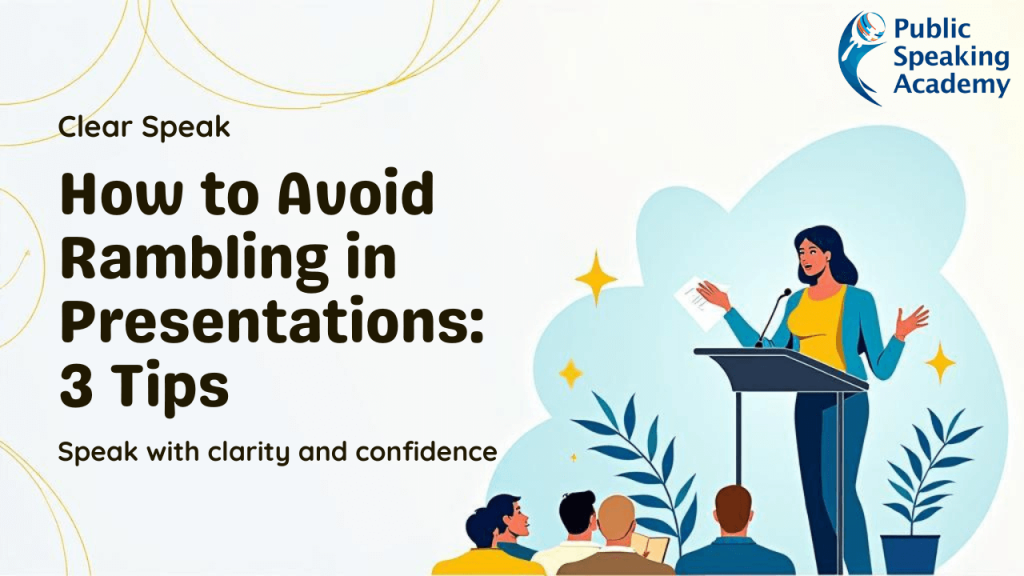
How to Avoid Rambling in Your Presentations: 3 Practical Tips for Clearer Public Speaking
Ever found yourself speaking in circles during a presentation? You’re not alone. One of the most common fears among public speakers—whether you’re a student, professional, or entrepreneur—is rambling. That moment when you feel stuck, unsure of what to say next, and end up repeating the same idea in slightly different words.
In this article, we’ll break down exactly what rambling is, why it happens, and more importantly, two practical techniques to help you avoid it. These public speaking tips are ideal for anyone looking to sharpen their presentation skills—especially if you’re preparing for a speech, interview, or even a startup pitch.
What Is Rambling in Public Speaking?
Rambling happens when a speaker:
- Struggles to think of what to say next,
- Ends up paraphrasing the same point again and again,
- Fails to move the presentation forward with new or deeper insights.
As a result, the audience gets lost or bored because the speaker isn’t making clear progress from one point to the next. In other words, your content feels like it’s going in circles rather than in a purposeful direction.
Why Is Avoiding Rambling Important?
For any effective communicator—whether you’re delivering a motivational speech, giving a school presentation, or leading a business pitch—clarity and flow are crucial. Without structure, your message loses impact, and your confidence can take a hit.
That’s where these two tried-and-tested tips come in.
Tip #1: Use Interrogative Pronouns to Structure Your Thinking
One powerful trick is to mentally rely on the interrogative pronouns—also known as the 5Ws and 1H:
Who, What, When, Where, Why, and How
These simple prompts can help you develop your points with purpose and variety.
For example:
If someone asks, “Why did you start this company?”, you could start with the motivation behind it (the “why”). Then, expand the conversation naturally by bringing in:
- The who: Who inspired or helped shape this purpose?
- The what: What was your biggest challenge or inspiration?
- The when and where: When and where did this idea come to life?
- The how: How did you turn your idea into a business?
By switching between these question types, you’re giving your speech layers, keeping it rich and engaging—without sounding repetitive.
This technique works especially well for impromptu speaking, interviews, or storytelling formats.
Tip #2: Start With a Clear Roadmap
Another key to avoiding rambling is to have a clear roadmap before you begin speaking.
Many people try to “wing it” and improvise the flow as they go. While that may work for experienced speakers, it’s risky. Without a structure in mind, you might forget your main points, repeat yourself, or wander off-topic.
Here’s what you can do:
Before your presentation, plan a basic structure:
- Introduction – What’s the main idea or goal?
- Key Points – What 2–3 subpoints will you cover?
- Conclusion – What final message should your audience walk away with?
This roadmap helps you stay on track from point A to point B and ensures your audience can follow your logic. Plus, it naturally prevents you from circling back unnecessarily or stalling mid-speech.
Whether you’re preparing for a school oral exam, corporate presentation, or public speaking competition, this clarity is key.
Tip #3: Use Signposting to Guide Your Audience (and Yourself)
A third way to avoid rambling is by applying a technique called signposting—a simple but effective method for keeping your ideas organised and your audience oriented.
When planning your presentation, make sure your points follow a clear, logical order—whether it’s chronological, sequential, or thematic. This helps not only your audience but also you as the speaker to stay on track.
Signposting refers to using verbal cues to let your audience know where you are in your speech. Instead of repeatedly saying “also,” try framing your points with clearer transitions like:
- “First, let’s explore…”
- “Next, we’ll look at…”
- “Finally, to wrap up…”
You can also begin your presentation with a brief roadmap of what’s to come. By giving listeners a clear structure from the beginning and reinforcing it with signposts along the way, your message becomes easier to follow—and you’re less likely to get lost or wander off-topic mid-speech.
This strategy is especially helpful in school presentations, persuasive speeches, and professional settings where clarity and pacing are crucial.
Why This Matters in Public Speaking Training
At Public Speaking Academy, we often see students—from kids to C-suite professionals—wrestle with rambling when nervous. But with structured frameworks like interrogative prompts and clear outlines, they grow in confidence, clarity, and charisma.
These skills don’t just make you a better speaker—they make you a better communicator in daily life.
If you’re looking to build these habits and sharpen your skills, consider enrolling in a public speaking course in Singapore or joining a presentation skills class for kids or teens. With guided coaching and regular practice, speaking clearly becomes second nature.
Key Takeaways: How to Avoid Rambling in Public Speaking
- Rambling = Repeating the same point without forward movement.
- Use interrogative pronouns (Who, What, When, Where, Why, How) to develop your ideas meaningfully.
- Plan a clear roadmap with an intro, main points, and conclusion before you speak.
- Add signposts like “First,” “Next,” or “Finally” to guide your audience through your structure.
- Logical flow improves your delivery and helps with memory recall.
- A structured approach builds confidence and boosts audience engagement.
- Great for impromptu speaking, business presentations, school oral exams, and interviews.
More tips on public speaking & communication skills
Check out our tips on the following five communication topics:
Speaking Confidence Building Strategy
Effective Presentation Techniques
Impromptu Speaking / Think-fast-on-the-feet skills
Our Public speaking & Presentation Skills Training Courses
If you’re keen on taking your communication skills to the next level, to improve your persuasive speaking skills through our training programs:
Click for more about our (weekly group classes) Public Speaking Courses for Adults
Click for more about our (2-day) public speaking/ presentation course for adults
Click for more about our (weekly group classes) Public Speaking Course for Kids / Children
Click for more about our (2-day) public speaking holiday program for Kids / Children
Click for more about our (2-half-day) DSA interview skills holiday program for Kids / Children

Leave a Reply